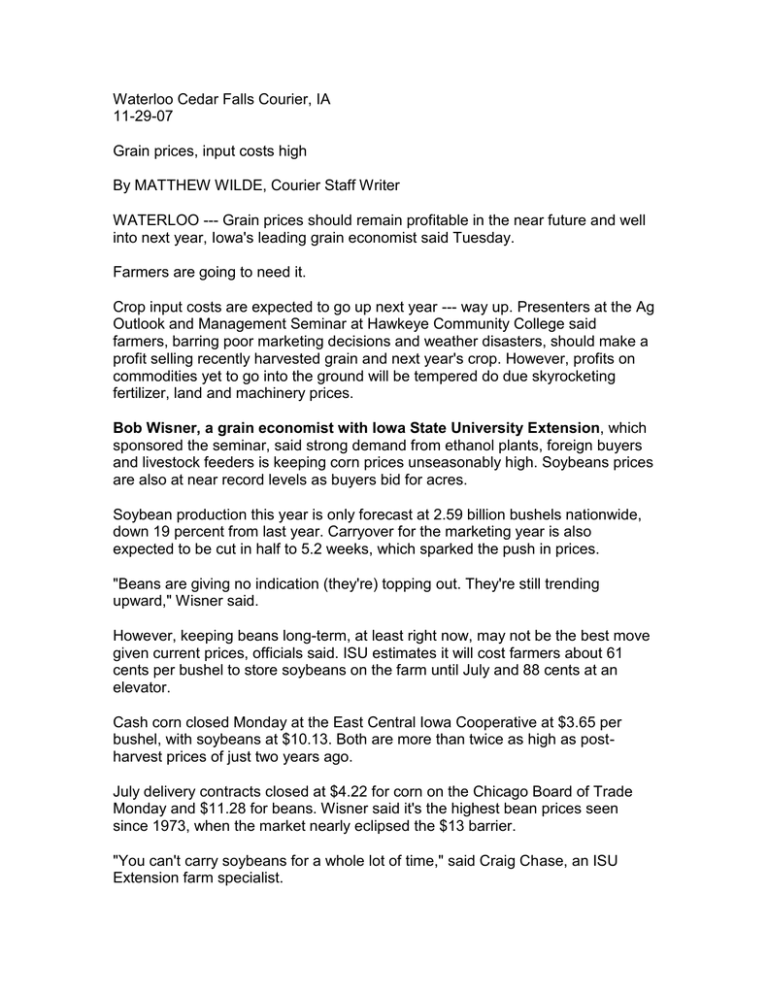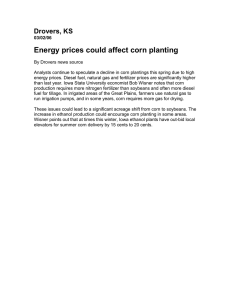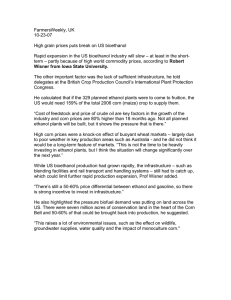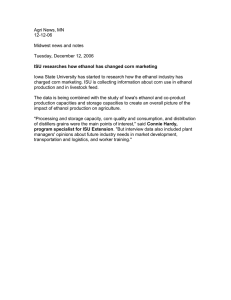Waterloo Cedar Falls Courier, IA 11-29-07 Grain prices, input costs high
advertisement

Waterloo Cedar Falls Courier, IA 11-29-07 Grain prices, input costs high By MATTHEW WILDE, Courier Staff Writer WATERLOO --- Grain prices should remain profitable in the near future and well into next year, Iowa's leading grain economist said Tuesday. Farmers are going to need it. Crop input costs are expected to go up next year --- way up. Presenters at the Ag Outlook and Management Seminar at Hawkeye Community College said farmers, barring poor marketing decisions and weather disasters, should make a profit selling recently harvested grain and next year's crop. However, profits on commodities yet to go into the ground will be tempered do due skyrocketing fertilizer, land and machinery prices. Bob Wisner, a grain economist with Iowa State University Extension, which sponsored the seminar, said strong demand from ethanol plants, foreign buyers and livestock feeders is keeping corn prices unseasonably high. Soybeans prices are also at near record levels as buyers bid for acres. Soybean production this year is only forecast at 2.59 billion bushels nationwide, down 19 percent from last year. Carryover for the marketing year is also expected to be cut in half to 5.2 weeks, which sparked the push in prices. "Beans are giving no indication (they're) topping out. They're still trending upward," Wisner said. However, keeping beans long-term, at least right now, may not be the best move given current prices, officials said. ISU estimates it will cost farmers about 61 cents per bushel to store soybeans on the farm until July and 88 cents at an elevator. Cash corn closed Monday at the East Central Iowa Cooperative at $3.65 per bushel, with soybeans at $10.13. Both are more than twice as high as postharvest prices of just two years ago. July delivery contracts closed at $4.22 for corn on the Chicago Board of Trade Monday and $11.28 for beans. Wisner said it's the highest bean prices seen since 1973, when the market nearly eclipsed the $13 barrier. "You can't carry soybeans for a whole lot of time," said Craig Chase, an ISU Extension farm specialist. For corn, though, it's a different story. Keeping corn for future sales may be a wise move. "There's signals this market may level off in the next several months," Wisner said. "We're close to the saturation with ethanol use in the U.S." However, high wheat prices, slowing ethanol growth, the possibility of more soybeans planted next year and less corn and poor corn crops in other countries due to drought could lead to stronger corn prices in the future. Plus, the market will apparently pay farmers to store corn. ISU estimates it will cost farmers about 58 cents per bushel to keep corn in bins on the farm until July and 84 cents off the farm. "What we're seeing now is the basis (the difference between local cash prices and futures prices) has no pattern. It's really driven by demand of ethanol plants, almost 100 percent," Chase said. Unlike year's past, it isn't common to see a 15-cent to 20-cent difference in corn prices in a 50-mile radius, the presenters said. Since ethanol plants have limited storage space and it costs too much money for facilities to temporarily shut down, officials said plants will pay to get corn, especially in the summer months as supplies dwindle. Wisner suggests forward contracting corn, but not several years out. Local demand and input costs are too uncertain. "I'm not a fan of aggressive multi-year sales," Wisner said. But if farmers already know their input costs, he said, "you can't go broke taking a profit." And that's the tricky part, experts said. The cost of raising corn and soybeans is rising at unprecedented rates. The latest ISU estimates put corn production costs next year at about $500 per acre. Five years ago it was about $350. In other words, farmers will need anywhere from $3.15 to $3.30 per bushel just to break even. That's figuring local land rents at about $180 per acre and anhydrous ammonia prices at about $500 per ton. However, Wisner said he's heard some fertilizer dealers are charging almost $800 per ton this fall. The demand for natural gas, a key ingredient in anhydrous, to power electric plants and from China to boost its corn yields are a primary factor, he said. "It's a global market for it. Supplies will continue to be tight; I hate to use the word shortage," Wisner said. Craig Sage, who farms north of Waterloo, attended to get some marketing tips and insights on production costs. After listening to Wisner and Chase, he plans to fine-tune anhydrous applications and concentration on profitability instead of yields. "It used to be you just put on a lot because it was cheap, and even a little extra to accommodate for loss. Things aren't like they used to be," Sage said. ISU estimates it will cost about $350 per acre next year to raise soybeans. That puts break-even rates between $7 and $7.30 per bushel, locally, officials said. Land costs make up the biggest portion of planting soybeans. Last year rental rates jumped by more than 20 percent, Chase said, and rates are expected, but not guaranteed, to go up a similar amount next season. "This is the $100,000 question," Chase said. To help farmers make planting decisions, ISU provides several Web-based tools. The most popular is Ag Decision Maker, located at www.extension.iastate.edu/agdm. Contact Matthew Wilde at (319) 291-1579 or matt.wilde@wcfcourier.com.






